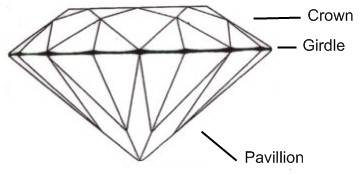The GIA will give any round diamond a maximum cut grade of “Very Good” to a diamond with a “Very Thin” girdle.
The girdle is the middle part of the diamond between the crown and pavilion. It doesn’t affect the light return of a diamond, unless it is “unusual”, and a smaller girdle, usually means a bigger spread – which leads to a diamond looking a lot bigger.

A very thin or extremely thin girdle will be more prone to chipping, especially if the crown angles are shallow. Therefore the durability of the diamond is weakened, hence the “Very Good” grade.
Whilst buying a diamond with a very thin girdle may seem to be an attractive proposition – a bigger spread and cheaper price due to a lower grade, one must consider:
- How big the crown angles are.
- The setting – for example, a pendant may be less prone to force on the sides.
- Whether you trust the setter not to chip it. Remember, a setter may only be paid $20 or so to set your diamond, and the risk of setting a diamond with a very thin girdle seems disproportionate to how much they are getting paid.